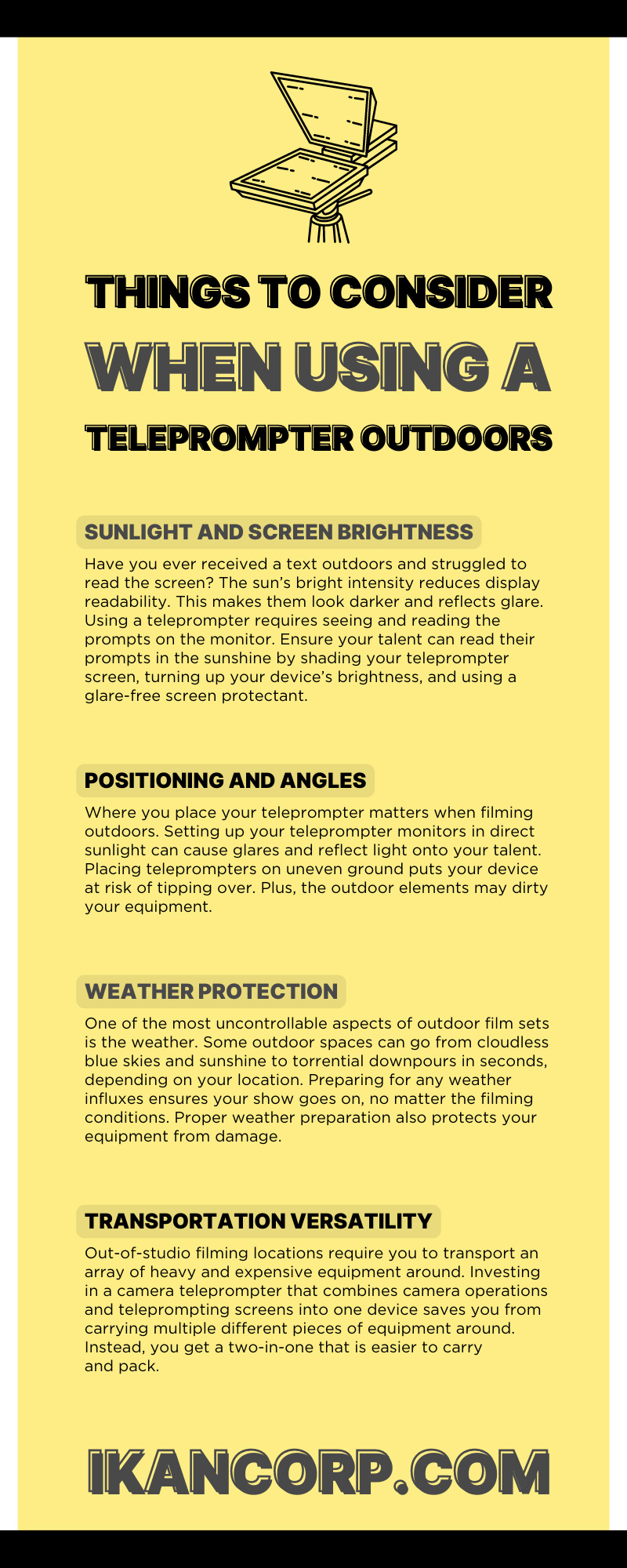
Teleprompters are the go-to film equipment for delivering flawless and confident on-camera performances. These innovative tools are like an on-set assistant that helps with scene cues and speech lines. For live performances specifically, understanding the reasons to use a virtual teleprompter can help you achieve professional results. Because it’s such an efficient piece of filming equipment, you may want to take teleprompters wherever you shoot.
Whether you’re heading outside for picturesque backgrounds or to deliver news at the heart of the story, filming in fresh air offers its fair share of on-set challenges. Unlike in the studio, outdoor environments are harder to control. Consider these five things when using a teleprompter outdoors and maximize your natural film location and teleprompter benefits to guarantee smoother outdoor production.
Sunlight and Screen Brightness
Have you ever received a text outdoors and struggled to read the screen? The sun’s bright intensity reduces display readability. This makes them look darker and reflects glare. Using a teleprompter requires seeing and reading the prompts on the monitor. Ensure your talent can read their prompts in the sunshine by shading your teleprompter screen, turning up your device’s brightness, and using a glare-free screen protectant.
Positioning and Angles
Where you place your teleprompter matters when filming outdoors. Setting up your teleprompter monitors in direct sunlight can cause glares and reflect light onto your talent. Placing teleprompters on uneven ground puts your device at risk of tipping over. Plus, the outdoor elements may dirty your equipment. If you get any debris in your teleprompter’s internal system, you can damage your device and cause it to malfunction. Carefully consider where you place your teleprompter when filming outside to minimize damage risks.
Weather Protection
One of the most uncontrollable aspects of outdoor film sets is the weather. Some outdoor spaces can go from cloudless blue skies and sunshine to torrential downpours in seconds, depending on your location. Preparing for any weather influxes ensures your show goes on, no matter the filming conditions. Proper weather preparation also protects your equipment from damage.
Showers and Sprinkles
Water is technology’s greatest enemy. Without the right protection, water damage can affect your teleprompter in many ways. Some of the worst water damages include the following.
Electrical Short Circuiting
When water comes into contact with internal circuity, it disrupts the flow of electricity. Any disruptions can fry sensitive electronic components, shut down your device’s internal systems, and render your teleprompter inoperable. Covering your teleprompter’s external ports and sealing any openings allows you to block water from reaching internal circuits.
Corrosion
When water reacts with metals, the oxygen in water oxidizes to form the infamous reddish-brown coating that weakens structural integrities. Rust can corrode your teleprompters and eat away at their metallic structures, causing irreversible damage. Investing in teleprompters made from rust-resistant materials and keeping your devices covered and dry better prepares you for outdoor teleprompting and rainy days.
Screen Damage
Water can damage your teleprompter screen in many ways. Dense and fast-dropping rain can generate enough force to impact your screen, which may crack and dent the surface. Droplets between the screen’s glass can cause bubbles, screen distortions, and more crack formations from the built-up pressure.
Mold and Mildew
Water trapped in your teleprompter’s crevises puts you at risk of growing mold. The moist and dark environment in the crevices provides the perfect breeding space for mildew spores, which can grow and interfere with your teleprompter’s internal components. Mold on your teleprompters also causes potential health risks as they compromise surrounding air quality.
Control System Malfunctions
Water in your teleprompter’s control systems causes many operational malfunctions, from unresponsive buttons to unintended command registries. Compromised buttons and knobs can render your teleprompter useless, especially if they are essential control switches.
Protect your teleprompter from showers and sprinkles by adequately covering your teleprompter with a tarp or buying a waterproof casing for the device’s main system. The more coverage, the lower your chances of water damage while out on the field.
Hot Sunshine
Too much heat exposure to your teleprompter can cause many different issues. Exposure to high temperatures overheats your teleprompter, frying its internal components and causing a system shutdown. Heat can also distort your teleprompter’s screen and reduce its battery lifespan. Shading your teleprompter devices from direct sunlight keeps the heat down and prevents your teleprompter from shutting down and overheating.
Freezing Temperatures
Cold days can also cause an array of teleprompting issues. Any frost and condensation can expose your teleprompters to water, causing risks of water damage. Additionally, frozen screens can crack. Running your teleprompter in cold temperatures also causes operational malfunctions. The cold slows down your teleprompter’s internal systems and drains your device’s battery supply as it uses more energy to generate heat itself. Keeping a heater near your equipment prevents your teleprompter from freezing and facing the wrath of extreme cold.
Foggy Humidity
Humidity can fog up screens, making the prompts on the monitor hard to read. Using an anti-fog spray, providing ventilation, and regulating your teleprompter’s temperature can keep your screens clean and clear of fog.
High-Force Winds
Strong winds can tip and shake your teleprompters. To combat high-force winds while filming, anchor your teleprompter with a sturdy and weighted mount. Sandbags are popular weight options for cameras and light stands.
Covering and protecting your teleprompter from the extremities of outdoor weather conditions ensures your device remains in top condition. Prepare your teleprompter for the different elemental exposures of outdoor shoots to experience minimal technical difficulties on set.
Equipment Power Supply
Teleprompters require a consistent power supply to operate. Unlike studio settings, the outdoors provides few outlet options. Whether your teleprompter is a plug-in or battery-operated device, supplying ample power to your teleprompt guarantees smooth filming.
Power up and keep your teleprompters from losing power mid-production by:
- Choosing an outdoor film location near an exterior outlet
- Charging up batteries and bringing spares on set
- Bringing a small generator or power bank on set
Transportation Versatility
Out-of-studio filming locations require you to transport an array of heavy and expensive equipment around. Investing in a camera teleprompter that combines camera operations and teleprompting screens into one device saves you from carrying multiple different pieces of equipment around. Instead, you get a two-in-one that is easier to carry and pack.
Whether you head out to a park or metropolitan outdoor space, implement the best out-of-studio practices to guarantee a successful shoot and protect your equipment. Keep these five things to consider when using a teleprompter outdoors in the back of your mind, and enjoy the benefits of filming outdoors and using a teleprompt.
Get ready for your next outdoor shoot with teleprompters from Ikan. Our selection of teleprompting equipment, from special teleprompting travel kits to PTZ camera teleprompters, gives you many ways to teleprompt outdoors with ease. Shop our teleprompt equipment today!

